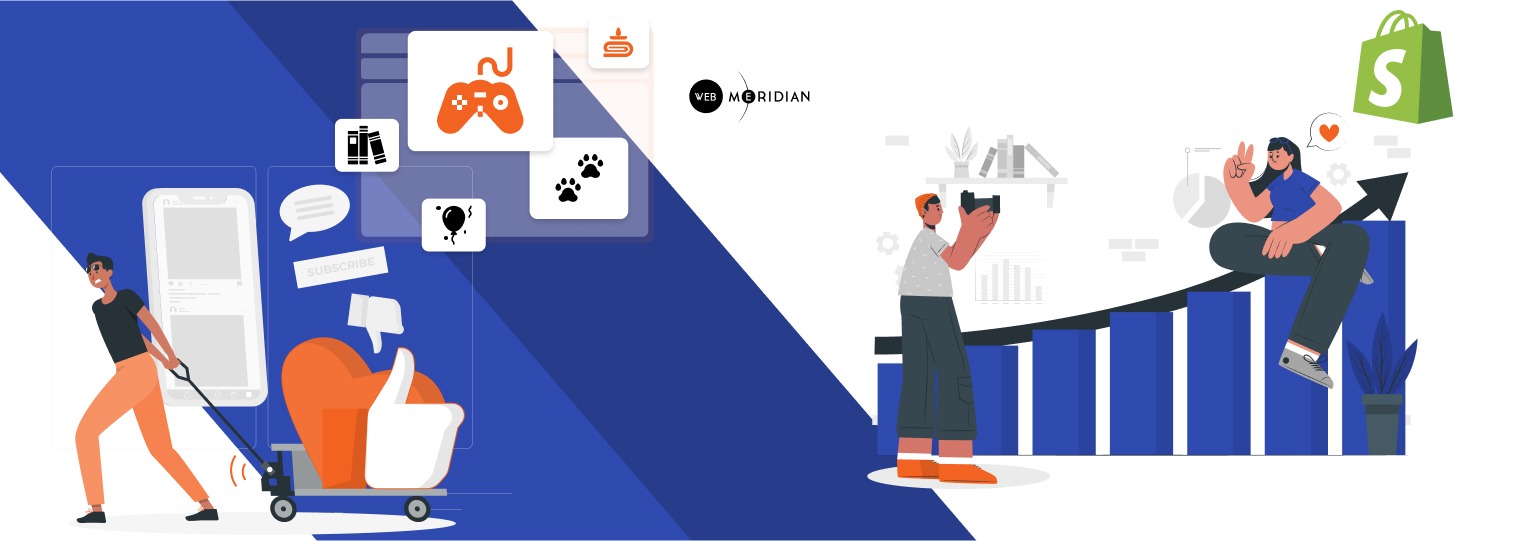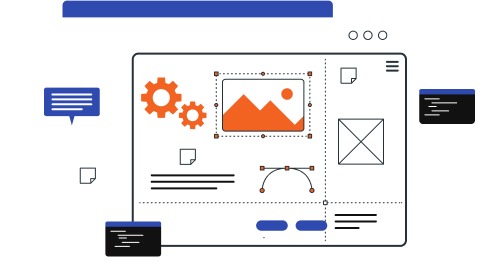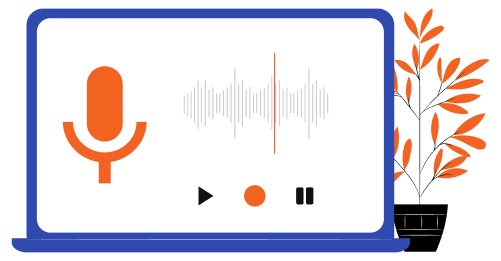This article will examine the year’s top Shopify eCommerce trends. We’ll look at what these trends imply for your business, how they can help you increase sales and income, and how they can help you optimise your eCommerce strategy.
There have never been more prospects or as much rivalry in the ecommerce market. As the return on ad spending falls, businesses are being pushed to focus on customer lifetime value and encourage brand loyalty.
The fundamental currency of the future of eCommerce is trust. Brands must be honest, authentic, and easily accessible to their customers, particularly on social media, where online consumers spend the majority of their time. With firms investing in video and live shopping, social commerce is at the heart of online buying for tomorrow’s consumers.
Let’s dive deeper into Shopify eCommerce trends in 2023.
- Future of B2B eCommerce
- Sell Everywhere Your Customers Are
- Add NFTs to Your Shopify Store
- Generating Content For Users In Their Native Language
- Establish a Live Shopping Experience
- The Elimination of Third-Party Cookies Compels Companies to Reconsider Personalisation
- Create Cutting-Edge Mobile Homepage Design
- QR Codes Are Widely Used
- Tell the Story About Your Brand
- Create Content to Improve Customer Loyalty & Retention
- Invest in Your Brand to Stay Ahead of the Competition
- Increase Client Confidence by Making Shipment Faster and More Transparent
- Summary
Get a Shopify Expert Consultation
Let our senior Shopify developer analyze your store and provide a comprehensive plan for eCommerce optimization to make your website stand out.

Concentrate on online revenue, particularly marketplaces, that is the future of B2B eCommerce. Small company statistics suggest that online sales continue to be the most crucial driver of development, even for those with a physical location.
According to the Shopify survey, 54 per cent of organisations indicated their commerce team must focus on online sales in order to meet their 2023 goals.
One approach to do so is to assess your store’s design. Is it aesthetically pleasing? Is it usable on mobile devices? Here’s a collection of fantastically designed stores to get you started.
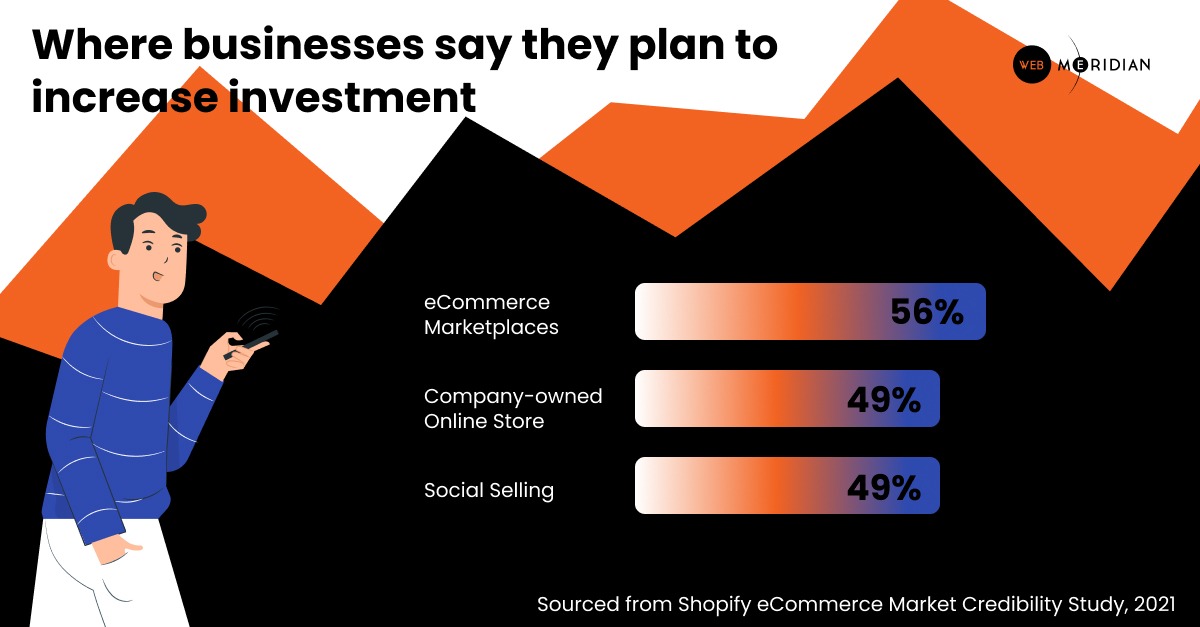
Future of B2B eCommerce
One of the hottest Shopify eCommerce trends 2023 is community building. You can develop a community around your brand with Shopify by leveraging different distribution methods to create a natural feedback loop with consumers about your products, services, or stories.
Shopify’s linked platform allows you to manage and analyse all of your channels in one location. 73 per cent of customers polled utilize numerous channels before making a purchase.
- With the Online Store sales channel, you can create a remarkable brand experience that shows your unique differentiators and values. It comes with easy-to-use layouts and drag-and-drop technologies that need little to no programming to bring your concept to life.
- Bring your goods to digital life with engagement and digital experience from augmented reality (AR), virtual reality (VR), and 3D media to provide a consistent online and offline purchasing experience.
Sell Everywhere Your Customers Are
Non-fungible tokens represent an intriguing potential for businesses to reward loyal supporters while also creating demand for their brand. Shopify Plus merchants that meet certain criteria can now sell NFTs online.
Both Etherum and Flow are currently available to approved merchants as part of the NFT beta. Merchants will be able to pick whatever blockchain they wish to sell on in the future based on their products and consumer base.
Catch the wave of Shopify development trends and participate in the NFT beta test.
Add NFTs to Your Shopify Store
Localising your website may make or break international sales. From the very beginning to the very end, it creates a pleasant client experience.
In fact, most customers in the Flow.io research concurred that the following pages on the website should be in their local language:
- Descriptions of products (67%)
- Reviews of products (63%)
- Process of checkout (63%)
The localisation process may occasionally seem daunting, like it’s an all-or-nothing proposition (whether it’s country-specific or why bother?). It isn’t.
Because of the respondents’ emphasis on navigation and “some” information, a site does not need to engage in comprehensive translation right once. Headlines, product names, and other highly examined site elements must be perfect.
Full-scale translation employing a native copywriter and regional idioms makes sense only once you’ve acquired traction.
Generating Content For Users In Their Native Language
Live shopping is one of Shopify eCommerce Trends in 2022/2023, which consists of video streaming events that resemble QVC-style product presentations, and is quickly becoming the brightest star in social commerce.
According to Dan Conboy, managing director of Shopify Plus agency Statement, Live shopping’s success may be attributed to the chance to not only present items but also link directly to a brand’s ecommerce platform to increase sales.
“Global companies have been inventing in this space for years, including Avon, Uniqlo, and Tommy Hilfiger,” he says. “But the technology is now available for firms of all sizes.”
Conboy notes that “customers demand even tighter and more genuine ties with the businesses they choose to purchase with.”
To further increase consumer engagement, loyalty, and brand distinctiveness in 2023, “live shopping might be a wonderful innovation to consider as part of your plan.”

Establish a Live Shopping Experience
Chrome will replace third-party cookies with browser-based tools and techniques aimed at balancing personalisation and privacy.
There is a new course towards a more privacy-friendly web.
So, how can brands and online retailers prepare for this?
- The need for true end-user consent to process personal data will persist long after third party cookies and the technologies replacing them.
- Re-strategise the whole outlook on customers experience and online ads based on a back-to-basics approach.
- Try to better understand your customers’ behaviour and their shopping habits via Google Analytics & Search Console.
- Carry out testing of your website’s user in order to get direct feedback and use it to improve user experience.
- Focus on customer retention in your marketing strategy.
- Analyse conversion rates to optimise your store.
To avoid having trouble with the tech part of the optimisation of your eCommerce site or implementing the hottest Shopify development trends, consider the full-stack services we offer.
Communities, openness, and shared values help online businesses rehumanize their brands.
- Personalisation is something that customers want. Consumers continue to expect tailored shopping experiences, even as restrictions make data monitoring more difficult and the major players phase out third-party cookie support.
- Personalisation is not a panacea for increasing consumer engagement. Brands innovate with first-party data, but personalisation isn’t enough to foster long-term consumer connections.
- Customer loyalty is being built through brand communities. Brand communities are becoming increasingly important in terms of increasing trust and brand equity, as well as promoting customer retention.
The Elimination of Third-Party Cookies Compels Companies to Reconsider Personalisation
Dominate Search Engines
Don't let your products go unnoticed. Implement the latest SEO trends and watch your visibility soar.

When it comes down to Shopify eCommerce trends, you should pay attention to mobile web design, there is no need to prove a well-known fact that mobile web traffic has actively grown over the last few years. You definitely know how it’s crucial to simplify your homepage design for mobile phones, keeping in mind intuitive and smooth user flow during mobile shopping.
How to design a mobile responsive website, right? Here are 4 of the best practices that will help you create a mobile-friendly website:
- Use drop-down menus. Give your users better control of the menu and straightforward access to categories or subcategories. BUT menus shouldn’t have more than two levels.
- Keep page elements to a minimum. A mobile screen has 4 times less space available for the same number of elements as a desktop. Therefore, not all the text or visual elements on your desktop website design will find their way (in the proper form) into the mobile version. It will help if you hide some of the unnecessary elements that don’t affect the main message.
- Add the ‘Back to Top’ button. Give your website, users instantly scroll to the top of your page in one click. As a result, you can increase Page depth (average number of website pages that your visitors view during a single session).
- Leverage mobile-only features. Use mobile animation, branded welcome screen, customized mobile menu, features with a few taps, and more other.
We prepare the best mobile website design examples that follow Shopify eCommerce trends:
Create Cutting-Edge Mobile Homepage Design
Years before the epidemic, QR codes appeared to be going extinct, only to reappear with fury as businesses and events sought to reduce the cross-contamination caused by cash, tickets, and receipts.
Today, QR codes are widely used in a variety of contexts, such as:
- restaurants where patrons may scan a code to read the menu, make an order, and pay for their meal without waiting for a waiter,
- physical stores where patrons can scan a code to access special offers and other product lines.
By scanning a QR code in-store, customers may use Decathlon’s “Scan & Go” app to bypass long lines and deliver their purchases to their door.
By 2025, there will be more than 2.2 billion QR code payment users worldwide or 29% of all mobile phone users.
QR Codes Are Widely Used
If you want to implement the hottest Shopify eCommerce trends, then be ready to analyse the best online stores which are running on various technologies.
- mophie – Leader in Portable Power Banks and #1 Selling Mobile Battery Case.
- Harvey Nichols – Luxury department store, Harvey Nichols, offers designer fashion, beauty, and food wine both online and in-store, including Knightsbridge, Leeds Edinburgh.
- Banbayu – Offers contemporary wallpapers from renowned designers around the globe A hand-picked selection of artisan wallpaper, prints and paintings.
- Cox&Cox – Online store for homeware, home decorations & home gifts.
- The New Craftsmen – The New Craftsmen curates, commissions and sells unique contemporary objects that are rooted in craftsmanship and narrative.

5 Examples of the Excellent, Innovative Homepage Design with Shopify eCommerce Trends
- Tip #1. At every customer touchpoint, emphasize your distinct points of difference and values. Examine your brand’s story and differentiators again. What is the purpose of your brand? What is your backstory? What are your company’s core values? What and who are the needs that your brand satisfies? These essential questions set you apart from your competition, fuel your brand identity, and should serve as the cornerstone for every brand-building activity.
- Tip #2. Demonstrate to your consumers that you share their beliefs. 52 per cent of buyers Shopify polled are more inclined to buy from a company that shares their beliefs, and 53 per cent of brands wants to create items that fit with their values by 2023. Maintain consistency. If you take an ethic of care on environmental or social concerns, show how those beliefs are reflected in your brand, out from top-down to your customer service staff. Patagonia, a firm that actively works for environmental problems, instils its ideals in every aspect of the business: its “Worn Wear” program encourages consumers to buy and sell used products, and its “Drive-Less” initiative awards staff for lowering emissions on their drive to work.
- Tip #3. Consider your staff to be a target audience for your brand. As your firm expands, it’s possible for the purpose of your brand to become forgotten farther downstream. However, your workers (including in-store retail staff and customer care teams) have an important role in how customers perceive your brand at every touchpoint. Consider your staff as a brand audience, and implement marketing programs to assist educate them on your brand’s purpose, experience, and message. This will increase the consistency and quality with which your employees express your brand value to consumers.
Tell the Story About Your Brand

Direct-to-consumer (DTC) businesses are also spending on online communities in order to humanize their brands, enhance client loyalty, and offset rising marketing expenses.
Brand communities are becoming increasingly important in terms of establishing trust and brand equity, as well as increasing consumer loyalty and retention.
Using the community, you may generate consumer loyalty and statistics.
When access to client data is so reliant on trust, it’s no surprise that businesses will spend more in customer loyalty and connection over the next year than practically any other customer acquisition and retaining approach.
As businesses seek to deepen consumer ties, several have turned to building a community. Brand communities have grown in popularity in recent years, and for good reason: they enhance customer retention and brand exposure while decreasing customer care expenses.
Explore more about effective customer retention strategies in the Nike’s success story.
Create Content to Improve Customer Loyalty & Retention
Supercharge Your Store for the Sales Rush!
Ensure peak season success. Our Adobe Business Practitioners conduct site audits to optimize your eCommerce weaknesses.

Increased competitiveness is one of the concerns of venturing into online marketplaces. It’s a frequent concern—40 per cent of firms believe growing competition would make it difficult for their commerce team to meet its objectives.
Marketers that demand rapid, measurable outcomes sometimes underestimate the importance of a brand, which is a longer-term investment.
While conversion rates are crucial, most customers have a brand in mind by the time they’re ready to buy. According to Google, more than 80% of shoppers perform their research online before making a purchase choice. A strong brand is required for a company to acquire a presence in the minds of consumers.
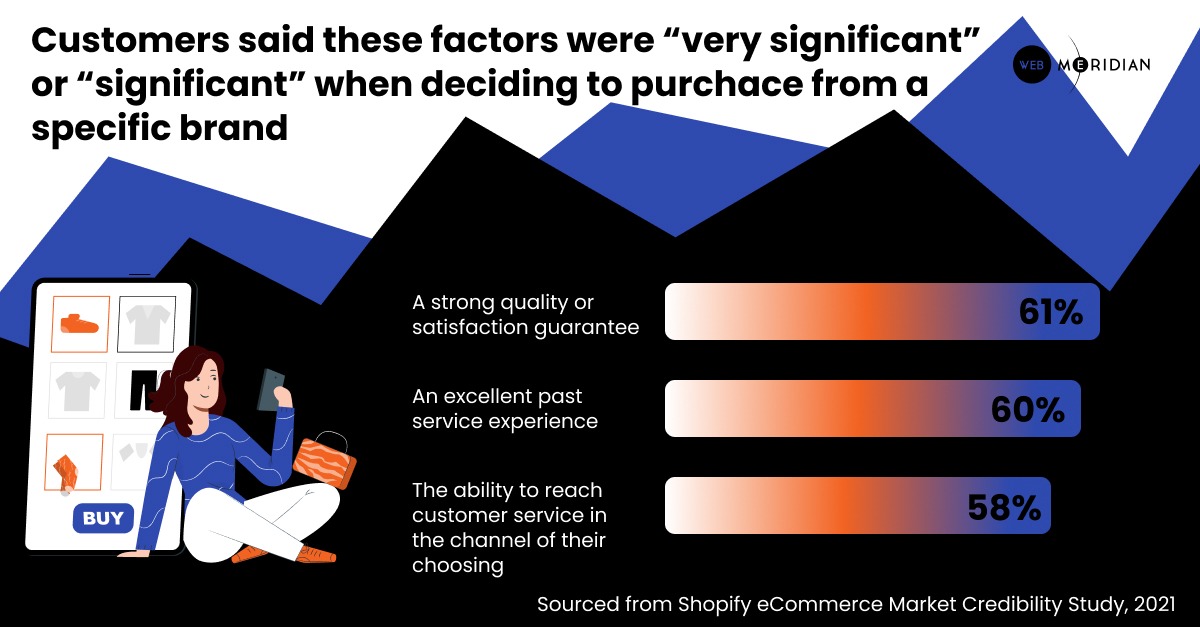
A strong brand not only improves the effectiveness of performance marketing in the near future but also serves as the foundation for long-term success. Strong brands attract more organic acquisitions, keep more consumers, and have the ability to raise prices—the most powerful profit-increasing lever. Brand identification and brand recognition will become even more important as the digital arena grows more cluttered.
However, we also know how to persuade people to select your brand over another. Customers informed us what they consider a “major” or “very substantial” effect on their choice to purchase from a given company in a Shopify poll.
Invest in Your Brand to Stay Ahead of the Competition

When purchasing online, it’s becoming common to discover free and fast shipping with estimated arrival date. Customers now demand this openness from marketplaces like Amazon, but it can be a challenging standard for small firms to satisfy.
Businesses highlighted three areas where they will invest in shipping in 2023: lowering shipping costs through free and flat-rate shipping, enhancing the flexibility of shipment and return policies, and modifying shipping methods to mitigate the effect of global shipping delays.
Free delivery is a tried-and-true way for improving conversion and order quantities, and some easy maths will help you determine if it’s worthwhile to give this to your clients.
Shipping clarity, defined as the ability to demonstrate clearly predicted arrival timeframes, is critical for both businesses and customers. 49% of firms want to invest in shipping transparency, while 46% of customers stated they search for it when buying.
Online commerce has enabled people to shop from anywhere on the globe, and staying competitive requires being able to ship everywhere. In fact, cross-border transactions accounted for 15% of all Black Friday Cyber Monday 2021 purchases.
Increase Client Confidence by Making Shipment Faster and More Transparent
You understand this better than anybody else that being in business requires ongoing adaptation, reevaluation, and fine tweaking. These Shopify eCommerce trends for 2023 might help you decide where to focus your attention and invest in the future year.
Take this information and use it to make 2023 your finest year ever.
Summary
No More Lost Customers!
We offer tech audit and implementing of new theme with a hot feature set to rekindle customer interest and drive additional sales.
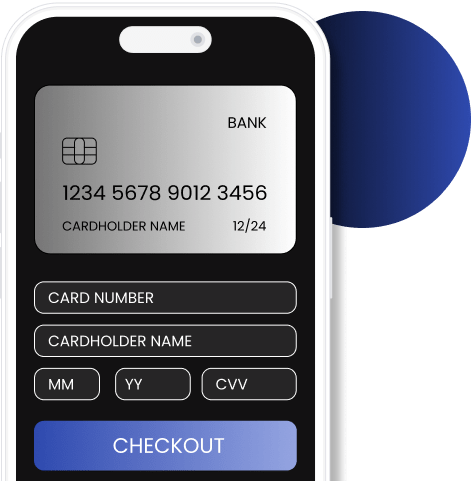
As a leading eCommerce platform, Shopify allows you to sell anything globally and not be geographically tied. Transform your brick-and-mortar store into a cutting-edge online shop with an outstanding shopping experience. We assist you to up your game by boosting your eCommerce strategy. Our experts make customers' experience more fulfilling with our Shopify eCommerce development services when visiting your online store.
The Best Option: Hire a Shopify Developer to create a massive, wholly customised website. As a result, large-scale project development might take months, depending on the complexity of the construction, which can eventually affect your company’s web development expenses. Total cost: Shopify subscription = from £22 per month; Template price = £39 – £195 one-off; Developer price = £6000 – £12500 one-off.
